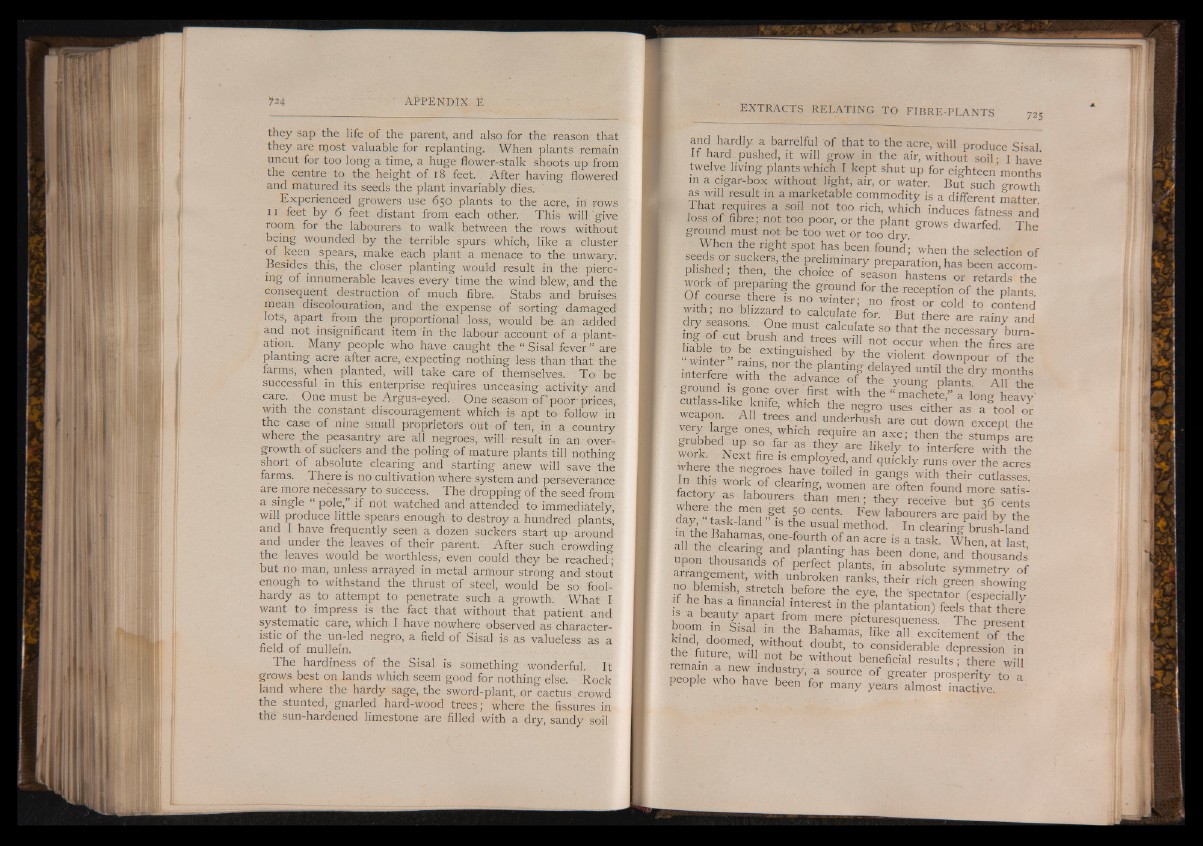
they sap the life of the parent, and also for the reason that
they are most valuable for replanting. When plants remain
uncut for too long a time, a huge flower-stalk shoots up from
the centre to the height of 18 feet. After having flowered
and matured its seeds the plant invariably dies.
Experienced growers use 650 plants to the acre, in rows
11 feet by 6 feet distant from each other. This will give
room for the labourers to walk between the rows without
being wounded by the terrible spurs which, like a cluster
of keen spears, make each plant a menace to the unwary.
Besides this, the closer planting would result in the; piercing
of innumerable leaves every time the wind blew, and the
consequent destruction of much fibre. Stabs and bruises
mean discolouration, and the expense of sorting damaged
lots, apart from the proportional loss, would be an added
and not insignificant item in the labour account of a plantation.
Many people who have caught the “ Sisal fever ” are
planting acre after acre, expecting nothing less than that, the
farms, when planted, will take care of themselves. To be
successful in this enterprise requires unceasing activity and
care. Gne must be Argus-eyed. One season of’ poor prices,
with the constant discouragement which is apt to follow in
the case of nine small proprietors out of ten, in a country
where ,the peasantry are all negroes, will result in an overgrowth
of suckers and the poling of mature plants till nothing-
short of absolute clearing and starting anew will save the
farms. There is no cultivation where system and perseverance
are more necessary to success. The dropping of the seed from
a single “ pole,” if not watched and attended to immediately,
will produce little spears enough to destroy a hundred plants'
and I have frequently seen a dozen suckers start up around
and under the leaves of their parent. After such crowding
the leaves would be worthless, even could they be reached;
but no man, unless arrayed in metal armour strong and stout
enough to withstand the thrust of steel, would be so foolhardy
as to attempt to penetrate such a growth. What I
want to impress is the fact that without that patient and
systematic care, which I have nowhere observed as characteristic
of the un-led negro, a field of Sisal is as valueless as a
field of mullein.
The hardiness of the Sisal is something wonderful It
grows best on lands which seem good for nothing else. Rock
land where the hardy sage, the sword-plant, or cactus, crowd
the stunted, gnarled hard-wood trees; where the fissures in
the' sun-hardened limestone are filled with a dry, sandy soil
and hardly a barrelful of that to the acre, will produce Sisal
If hard pushed, it will grow in the air, without soil; I have
twelve living plants which I kept shut up for eighteen’months
m a cigar-box without light, air, or water. But such growth
as; will result in a marketable commodity is a different matter
That requires a soil not too rich, which induces fatness and
loss o f fibre; not too poor, or the plant grows dwarfed The
ground must not be too wet or too dry
When the right spot has been found’- when the selection of
S h e d " 3 5 ”® ° Pfe,phshed then, the choiciem iorf sye ason hastens or br.eetua radcsc othmel
work of preparing the ground for the reception of the plants
Of course here is no winter; no frost or cold to contend
with; no blizzard to calculate for. But there arerainvanrl
M hr h"e T “ Ca‘CUlate S° *ha‘ b»“ -
h i , . 1 “ Sh and. trees wil1 not When the fires are
a , . e. extinguished by the violent downpour of the
* X ' t h e ^ £ “„ 7 a eeayed ,thJV
ground is g o n e Z C ^ - f . o u g ^ e a w
wweeaappoonn. 'AAllll " t;r^ee s anfd uHnde rTbugsrho aUrsee sc ueti tdho^w na s exac etpoot l thoer
°ne\ Which re<luire an ^ e ; then the stemps are
grubbed up so far as they are likely to interfere with the
who S H 13 uemployed> and da rkly runs over the acres
7n This w o r T T 3, haVG t0ilGd " with their cut W s
factor y I U earT ’ Women are often found more satis-'
» 1 labourers than men; they receive but 36 cents
I B 8 task 3 8 3 1 i t CenT' FeW lab°Urers are paid ^ the
in th i fu 15 tbe usuaI method. In clearing brush-land
m the Bahamas, one-fourth of an acre is a task. When at last
all the clearing and planting has been done, and thousands
upon thousands of perfect plants, in absolute symmetS of
arrangement, with, unbroken ranks, their rich g r in showing
iThT?™ V tret^hi -befbre the eye’ the spectator (especially
f he has a financial interest in the plantation) feels that there
hnom • c- a? a-rt 1i0m mere Pmturesqueness. The present
kind rJ0 j m the Bahamas, like all excitement of the
ind doomed without doubt, to considerable depression in
rem,Tn a6' • n,ot be without beneficial results; there will
neonlc 1ne^ lndustry, a source of greater prosperity to a
people who have been for many years almost inactive.